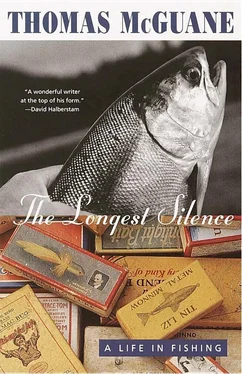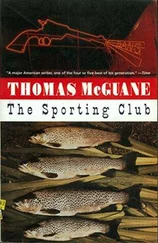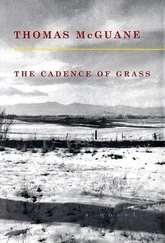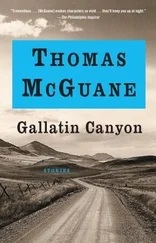Back to my hotel for a snack of perch soup, reindeer, and cloudberries in the dining room, then dreams of Atlantic salmon in Russia.
THE TARMAC AT MURMANSK was under repair and so our small group of Americans and Brits were diverted into a military airport. We stood near a plywood shanty, awaiting transport to the Soviet helicopter, its red star painted over. It would carry us to sixty-seven degrees north latitude, above the Arctic Circle, to our camp on the Ponoi River, three hundred fifty miles of wild Atlantic salmon water springing from a tundra swamp and flowing to the Barents Sea.
We took the time to inspect the pale blue fighter planes parked in front of bulldozed gravel ledges. They looked like state-of-the-art military equipment, but canvas had been thrown over the canopies, there was at least one flat tire, and they now belonged to a discarded chapter of world politics and other cerebral fevers. The hearty, cheerful Russian woman who was our translator for the moment gestured to the airplanes and said, “You like some military secrets?”
We boarded the enormous helicopter and put in our earplugs, sitting on benches amid duffel bags and rod cases. The Russian crew nodded in that enthusiastic, mute way that says, We don’t know your language. The helicopter lifted off to an altitude of about two feet. I looked out the window at the hurricanes of dust stirred by the rotors and then the helicopter roared down the runway like a fixed-wing aircraft and we were on our way.
In very short order, the view from the window was of natural desolation, rolling tundra, wisps of fog, and alarming low-level whiteouts. Even through my earplugs came a vast drumming of power from the helicopter’s engine. As I often do when confronted with a barrage of new impressions, I fell asleep, chin on chest, arms dangling between my knees, looking like a chimp defeated by shoelaces.
After an hour and a half, we stopped at a rural airfield and got out to stretch while the crew refueled, a task they performed with cigarettes hanging from their lips. Parked on this airfield were enormous Antonov biplanes built in the 1940s. A Russian mechanic told us that some of them had American engines. These were great cargo-hauling workhorses in Siberia, and from time to time we would see them flying over the tundra at a snail’s pace.
We reboarded, joined by a very pretty Russian girl carrying an armload of flowers. She smiled at everyone with the by now familiar mute enthusiasm while the helicopter once again roared into flight. We all mused on this radiant flower of the Russian north, working up theories about her life and dreams. Everything was so wonderfully foreign that later we were slow to acknowledge that she and her husband were our talented cooks from Minnesota.
Landing on a bluff above the Ponoi River, we could see both the camp and the river. The camp was a perfectly organized congeries of white tents of varying sizes, and once I was installed in mine, I briefly stretched out on my bunk to take in that bright sense of nomadic domesticity that a well-appointed tent radiates. In this far north latitude, I knew that the sun would be beaming through my canvas day and night. In one corner was a small Finnish woodstove that in our sustained spell of warmth would never be used.
We were instructed about the angling at the first dinner. An amusing and slightly imperious Englishman named Nicholas Hood picked the first pause between syllables during the official briefing to forgo dessert and descend to the river with his sixteen-foot Spey rod. I was impressed by his deftness in effecting a warp-speed fisherman’s exit without getting caught at it. I had just given an old household toast of ours, “Over the lips, over the gums, look out stomach, here it comes.” To which Hood responded, “Cerebral lot, your family,” and was out of there. One of my companions, Doug Larsen, a superb outdoorsman, remarked that Hood slept with one leg in his waders. I do like to hit the ground running in these situations, but by the time I could disentangle myself Hood was stationed midway down the Home Pool cracking out long casts and covering water like one who’d bent to this work before. “Any sense of the protocol on fishing through here?” I asked.
“Go anywhere you like,” he said, far too busy to get into this with me. So I went, I thought, a polite distance below him and began measuring several long casts onto the tea-colored water. English salmon anglers think that our single-handed rods are either ridiculous or inadequate or simply bespeak, especially when combined with baseball hats, the hyperkinetic nature of the people who use them. One Englishman fishing here earlier in the season had stated plainly that he didn’t think Americans should be allowed to fish for salmon at all.
At the end of one quiet drift, a salmon took, ran off with the fly line and, well into the backing, cartwheeled into the air. He put up a strong, fast fight and I had to follow him down the beach to a small cover, where I tailed him. I looked down at the salmon, at eight pounds not large, but a wonderful, speckled creature, a pure and ancient product of the Russian arctic. I slipped the barbless hook from the corner of his mouth and this brilliantly precise fish, briefly in my hand, faded like an image on film, into the traveling depths of the Ponoi.
When I returned to my spot on the pool, there was Nicholas Hood, beaming and fishing at once. “Well done!” said Hood, showing surprising pleasure at my catch. As we would see, Hood was much too able a fisherman to be insecure about anyone else’s success.
So was the talented Doug Larsen, who fascinated me with his expansion of the carp family: the specklebelly geese so popular among Texas gunners were “sky carp,” the grayling with their tall dorsal fins that darted out after our flies were “sail carp.” I know he wanted to place the enormous salmonid of the Danube and other waters, the taimen, into some remote branch of the carp family. But it wouldn’t go. The Russians who fished for them, he explained with ill-concealed disgust, waited until the taimen made his first jump, then let him have it with a twelve gauge. The only way to land them, really, and one that put aesthetically pleasing or even polite tackle out of the question. You would be at one with the shark assassins of Montauk and other brutes.
Larsen had brought with him our third companion, a Mr. Duff, who listed among his shadowy achievements giving investment tips to Mookie Blaylock. During the course of our week’s angling it became clear to me that the suave, well-dressed, and neatly coiffed Mr. Duff, introduced to me as having warmed up for Atlantic salmon by float-tubing for bluegills on their spawning beds, was a werewolf. His attempts at angling innocence, like asking whether a Near Nuff Frog would be a good fly to tie on, didn’t fool me even in the beginning. Something about the space between his eyes put me on the qui vive. He was into fish all week and stood on the banks of the tundra river at evening and howled like a Russian wolf to commemorate each catch. Not quite physically powerful enough to pinch down the barb on his hook, he had other strengths. Setting off on my middle-of-the-night excursions, I realized that when I reached the river, the wolf would be there. In the end, we accepted Mr. Duff as he was, a wild dog, saliva glistening in the corners of his mouth, chastely marcelled waves of blond over his forehead, and a gymnast’s ability to fish up to, around, and past you, nipping continuously at your water, as well as an unswerving, otherworldly need to catch the most fish. In other words, a werewolf.
Larsen and I were no longer comfortable with our considerable experience in angling for sea-run fish. We were being hunted down by this bluegill jock and had to exhaust our reserves of strength and knowledge to stay ahead of him. And the Ponoi rewarded him frequently as he gazed reflectively through his cigarette smoke. Incidentally, while he always had a cigarette smoldering between his lips, I never saw him light one. This primeval or eternal cigarette ought to be a final clue for any reader who needs one.
Читать дальше












